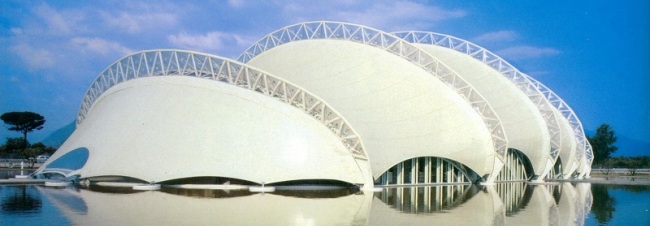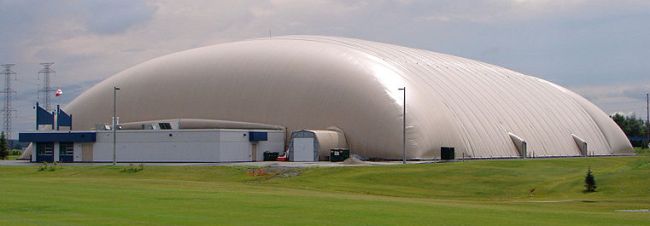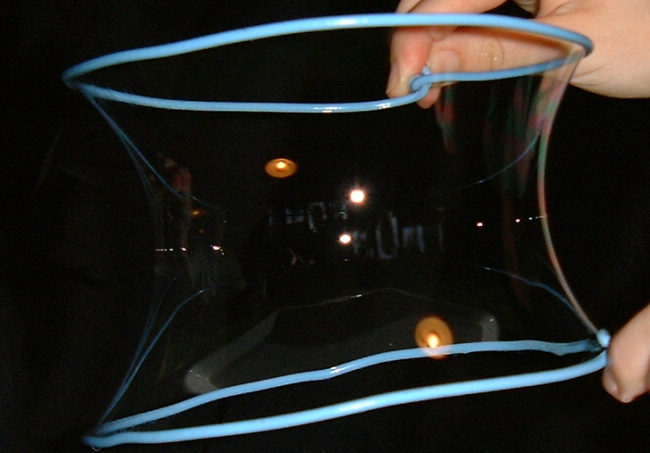The structural behaviour of architectural fabric structures
Contents |
[edit] Introduction
Fabric structures are a form of tensile structure in which a membrane is 'stretched' to form a structurally stable surface. Typically, the membrane is formed by a fabric, consisting of a woven base cloth, coated on both sides with an impermeable polymer, and sometimes a durable topcoat, held in position by tension forces imposed by a structural framework, a cabling system, internal air pressure or a combination.
[edit] Architectural fabrics.
Typically, fabric structures are formed using PTFE coated glass, or PVC coated polyester, although there is an increasingly wide range of other materials available. For more information see: The development of structural membranes.
The fabric itself it generally very thin, approximately 1mm thick. It has very little compressive strength, but very high tensile strength. Woven glass fabrics are stronger in tension than steel. Different types of membrane are available depending on the use, longevity and tensile strength required.
Typical tensile strengths are set out below:
- Type 1: 3,000 N/5cm
- Type 2: 4,000 N/5cm
- Type 3: 5,550 N/5cm
- Type 4: 7,000 N/5cm
- Type 5: 9,000 N/5cm
Individual pieces of fabric may be welded, heat sealed, glued or sewn together to form larger panels. Steel cables may be attached to the perimeter of the panels, to pull them into their desired positions.
[edit] Structural form
Fabric structures are generally tensioned and given their structural stability by their doubly-curved shape, which may be anticlastic or synclastic.
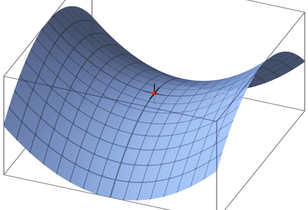
|
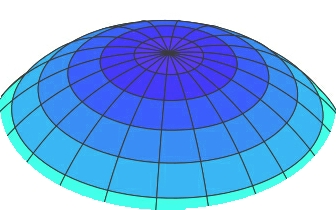
|
[edit] Anticlastic
An anticlastic surface (or a saddle shape), is a surface in which the two axes of the surface curve in opposite directions, that is, the centres of curvature are located on opposite sides of the surface. A hyperbolic paraboloid is an example of an anticlastic surface.
Anticlastic shapes tend to be formed by steel cables and masts or arches pulling them into tension. Whilst the fabric itself may be very thin, the tensile force imposed on it to ensure it remains stable under load can be high, and so the supporting structure required to transfer loads to the foundations can be significant.
[edit] Synclastic
A synclastic surface (or a dome shape), is a surface in which the two axes of the surface curve in the same direction, that is the centres or curvature are on the same side of the surface.
Synclastic surfaces are typically created by inflation (sometimes referred to as air-supported structures). Air pressure within the enclosure maintains the form of the surface when it is tensioned. The is similar to blowing up a balloon, but the pressure is very low so that it is generally not noticeable to occupants.
[edit] The effect of curvature
Doubly-curved surfaces can be tensioned without distorting their form, as the opposing curvatures balance each other at every point on the surface. Tensioning the fabric reduces its elasticity so that it will distort less when subsequently loaded, such as under wind load or snow load.
In addition, the geometry of the curvature itself means that any extension of the fabric under load results in a relatively smaller deflection than would be apparent in a flatter, or less curved fabric.
So the greater the curvature and the greater the pre-tensioning of the fabric, the less it will distort under load.
[edit] Structural design
A range of techniques can be used to design and analyse the stressed skin of fabric structures and to determine the optimum structural shape.
This process was initially carried out using relatively simple mathematical techniques and model making using wire frames and soap films to determine optimum forms, sometimes described as ‘minimal surfaces’.
It is only relatively recently that it has been possible to model the non-linear, dynamic behaviour of architectural fabrics (in which a change in one part affects all other parts and vice versa) using specialist form-finding software. This allows designers to vary the elements, boundary conditions and geometry of the design and rapidly determine the most efficient structural solution.
This software can also be used to generate patterns for automatically cutting the fabric panels to create the form required.
[edit] Related articles on Designing Buildings Wiki
- Anticlastic.
- Architectural fabrics.
- Carbon fibre.
- ETFE.
- Fabric structures.
- Polyvinyl chloride PVC.
- Principles of enclosure.
- PTFE.
- Structural principles.
- Tensile structures.
- Thermal behaviour of architectural fabric structures.
- The history of fabric structures.
- The development of structural membranes.
- The thermal behaviour of spaces enclosed by fabric membranes.
Featured articles and news
Government consultations for the summer of 2025
A year of Labour, past and present consultations on the environment, the built environment, training and tax.
CMA competitiveness probe of major housing developers
100 million affordable housing contributions committed with further consultation published.
Homes England supports Greencore Homes
42 new build affordable sustainable homes in Oxfordshire.
Zero carbon social housing: unlocking brownfield potential
Seven ZEDpod strategies for brownfield housing success.
CIOB report; a blueprint for SDGs and the built environment
Pairing the Sustainable Development Goals with projects.
Types, tests, standards and fires relating to external cladding
Brief descriptions with an extensive list of fires for review.
Latest Build UK Building Safety Regime explainer published
Key elements in one short, now updated document.
UKGBC launch the UK Climate Resilience Roadmap
First guidance of its kind on direct climate impacts for the built environment and how it can adapt.
CLC Health, Safety and Wellbeing Strategy 2025
Launched by the Minister for Industry to look at fatalities on site, improving mental health and other issues.
One of the most impressive Victorian architects. Book review.
Common Assessment Standard now with building safety
New CAS update now includes mandatory building safety questions.
RTPI leader to become new CIOB Chief Executive Officer
Dr Victoria Hills MRTPI, FICE to take over after Caroline Gumble’s departure.
Social and affordable housing, a long term plan for delivery
The “Delivering a Decade of Renewal for Social and Affordable Housing” strategy sets out future path.
A change to adoptive architecture
Effects of global weather warming on architectural detailing, material choice and human interaction.
The proposed publicly owned and backed subsidiary of Homes England, to facilitate new homes.
How big is the problem and what can we do to mitigate the effects?
Overheating guidance and tools for building designers
A number of cool guides to help with the heat.
The UK's Modern Industrial Strategy: A 10 year plan
Previous consultation criticism, current key elements and general support with some persisting reservations.
Building Safety Regulator reforms
New roles, new staff and a new fast track service pave the way for a single construction regulator.






